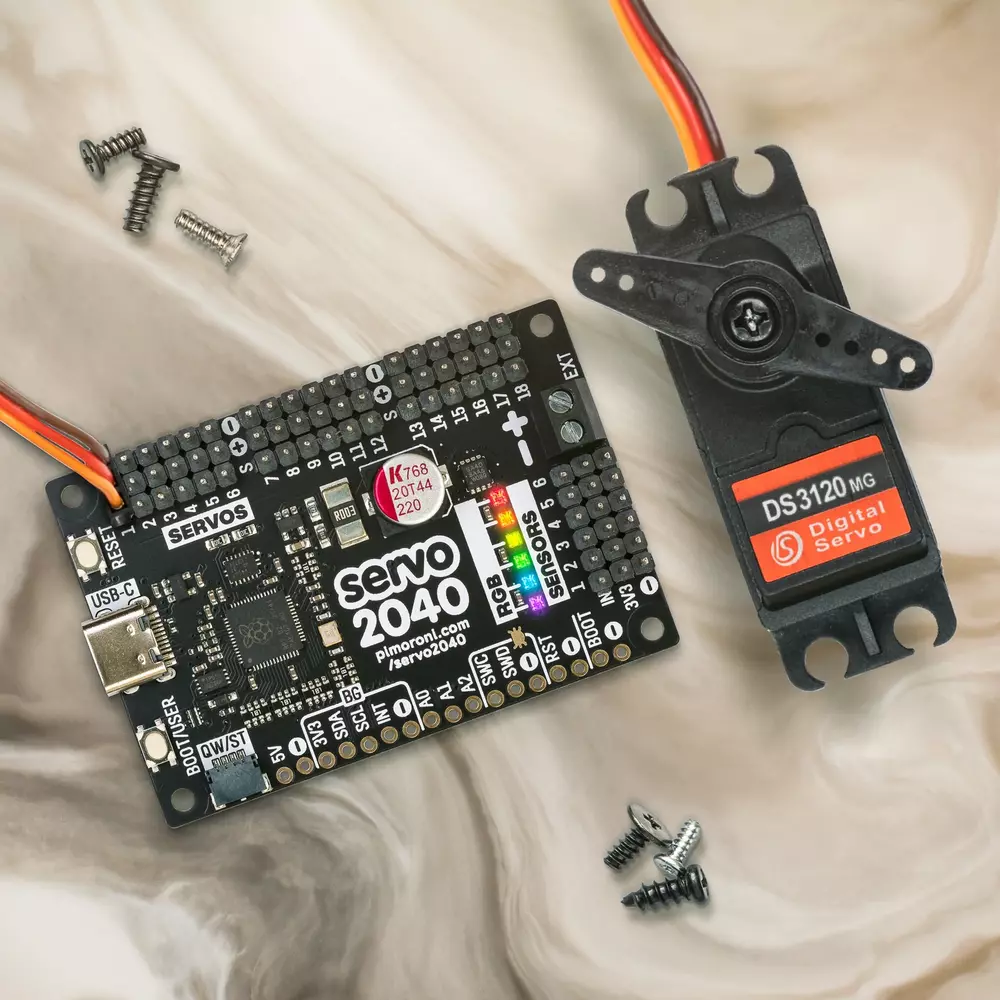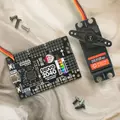Pimoroni Servo 2040 - 18 Channel Servo Controller

Description Links Attachments
Build the hexapod/robot arm/other articulated contraption of your dreams with this all-in-one RP2040 powered servo controller with current measurement, sensor headers and RGB LEDs.
Servo 2040 is a standalone servo controller for making things with lots of moving parts. It has pre-soldered pin headers for plugging in up to 18 servos - enough for the leggiest of hexapod walkers or plenty of degrees of freedom for your robotic arms, legs or tentacles. Servos can be pretty power hungry, especially the chunky ones, so we've added some neat current monitoring functions so you can keep an eye on power consumption.
There's six addressable RGB LEDs (AKA Neopixels) for visual feedback and status reports, plus pin headers to connect up to six analog sensors - useful for sensing where the ground is, if you're about to crash into a wall, or how much pressure The Claw is exerting on your hapless test subject. We've also popped a QW/ST connector on there, to make it super easy to add a Qwiic or STEMMA QT breakout or two.Servo 2040 is supported by a well documented C++/MicroPython servo library with lots of examples to show you how to use the individual features (and everything together).
RP2040 x servos
We've used RP2040 as the core of this board because of the flexibility of its Programmable IOs (PIOs). Traditionally, each servo needs to be connected to its own PWM capable channel on the microcontroller. RP2040 only has 16 PWM channels, but it's possible to drive up to 30 servos using the magic of PIOs (if you're canny with wiring). RP2040's PIOs are also super fast, so they can drive servos with sub microsecond resolution.
We've built the RP2040 microcontroller right into Servo 2040, so you don't need separate microcontroller and servo driver boards. This makes for nice compact builds - perfect for small robots!
Features
- Powered by RP2040 (Dual Arm Cortex M0+ running at up to 133Mhz with 264kB of SRAM)
- 2MB of QSPI flash supporting XiP
- 18 sets of header pins for connecting 3 pin hobby servos
- Supports higher voltage servos (up to 11V) *
- 6 addressable RGB LEDs/Neopixels
- 6 sets of header pins for connecting analog sensors
- Onboard voltage and current sensing
- Reset and BOOT button (the BOOT button can also be used as a user button)
- USB-C connector for programming and power (3A max)
- Screw terminals for supplying external power (with reverse polarity protection) (10A max continuous current)
- Qw/ST (Qwiic/STEMMA QT) connector for breakouts
- Fully-assembled (no soldering required)
- C++/MicroPython libraries
- Schematic
- Mechanical drawing
Software
Because it's a RP2040 board, Servo 2040 is firmware agnostic! You can program it with C/C++, MicroPython or CircuitPython.
Our C++/MicroPython libraries will help you get the most out of Servo 2040, they're packed with powerful features for working with servos. You'll get best performance using C++, but if you're a beginner we'd recommend using our batteries included MicroPython build for ease of getting started.
You can also use CircuitPython on your Servo 2040, if you want access to all the nice conveniences of Adafruit's ecosystem (note that you will only be able to control up to 16 servos with CircuitPython).
Connecting Breakouts
If your breakout has a QW/ST connector JST-SH to JST-SH cable, or you can easily connect any of our I2C Breakout Garden breakouts with a JST-SH to JST-SH cable; coupled with a Qw/ST to Breakout Garden adaptor.
- List of breakouts currently compatible with our C++/MicroPython build.
Notes
- Measurements: 62mm x 42mm x 12mm (L x W x H, including connectors). The mounting holes are M2.5 and 2.7mm in from each edge.
- * If you want to run servos with a higher voltage than 5V, you'll need to cut the 'Separate USB and Ext. Power' trace on the back of the board to prevent the RP2040 being damaged by the increased voltage.
- If you cut this trace you'll need to provide separate power for the board logic (through USB or the 5V on the broken out header).
- When programming a battery powered robot through USB we'd recommend using something like a data only USB adaptor to avoid back-powering your computer, or the battery.
About RP2040
Raspberry Pi's RP2040 microcontroller is a dual core ARM Cortex M0+ running at up to 133Mhz. It bundles in 264kB of SRAM, 30 multifunction GPIO pins (including a four channel 12-bit ADC), a heap of standard peripherals (I2C, SPI, UART, PWM, clocks, etc), and USB support.One very exciting feature of RP2040 is the programmable IOs which allow you to execute custom programs that can manipulate GPIO pins and transfer data between peripherals - they can offload tasks that require high data transfer rates or precise timing that traditionally would have required a lot of heavy lifting from the CPU.
Properties
| Brand | Pimoroni |
| Model | PIM613 |
Alternative products
- Raspberry PI Pico WH - With soldered headers € 8,10 View product
- Cytron Maker Pi Pico: Simplifying Raspberry Pi Pico for Beginners € 14,90 View product
- In stock Raspberry Pi Pico 2 H € 8,80 View product
- In stock Raspberry Pi Pico 2 € 7,95 View product
- In stock Raspberry Pi Pico 2 WH (with headers) € 11,- View product
- Raspberry PI Pico - Soldered headers € 7,05 View product
- In stock Raspberry Pi Pico 2 W € 9,25 View product
- Pimoroni Keybow 2040 - Tactile keys - PIM568 € 66,- View product
- In stock Raspberry PI Pico W € 8,10 View product
- Raspberry PI Pico € 5,60 View product
- Cytron Maker Pico with Pre-Soldered Raspberry Pi Pico W (Wireless) € 18,25 View product
- Pimoroni Keybow 2040 - Linear (quiet) keys - PIM561 € 66,- View product
- Pimoroni Badger 2040 + Accessory Kit - PIM610 € 30,25 View product
- In stock Pimoroni Tiny 2040 - 8MB Headered - PIM592 € 12,30 View product
- Pimoroni Plasma 2040 - PIM582 € 17,- View product
- Kitronik Discovery Kit for Raspberry Pi Pico (Pico Included) € 20,85 View product
- Cytron Maker Pi Pico Mini - Pre soldered pico € 15,70 View product
Related products
- In stock Sparkfun Reversible USB A to C Cable - 0.3m € 7,30 View product
- Raspberry Pi USB micro-B to USB-C adapter (Black) € 2,40 View product
- Sparkfun Panel Mount USB-C Extension Cable - 6" € 18,50 View product
- In stock Sparkfun USB 3.1 Cable A to C - (3 Foot/0.91 meter) € 10,- View product
- Deal In stock -48 % Sparkfun USB 2.0 Type-C Cable - 1 Meter € 8,25 € 4,30 View product
Customer questions
Customer Reviews
Suggested products
- In stock Opencircuit HC-SR04 Ultrasonic distance detection module € 2,15 View product
- Opencircuit MG90s 9G micro servo motor € 3,30 View product
- Opencircuit Gift card View product
- In stock Adafruit DS1307 Real Time Clock Assembled Breakout Board € 9,50 View product
- DFRobot Devastator Tank Mobile Robot Platform (Metal DC Gear Motor) € 105,25 View product
- 5 pieces In stock Opencircuit BS170 MOSFET N-Channel - 5 pcs € 3,10 View product
- In stock Opencircuit ZVP3306A Power MOSFET, P Channel, 60V, 160mA, 14 Ohms, E Line - Through Hole € 2,70 View product
- Pololu 3pi+ 32U4 Robot - Turtle Edition (75:1 LP Motors) - Assembled € 187,20 View product
- Whadda Dc lab switching mode power supply 0-60 vdc / 0-15 a max with lcd display € 425,- View product
- Whadda Dc lab switching mode power supply 0-60 vdc / 30 a max with led display € 712,85 View product
- 100 pieces In stock Perel Nylon cable ties - 7.6 x 400mm - black - 100 pcs € 8,90 View product
- Itead SONOFF iHost Smart Home Hub - 4GB € 108,95 View product
- Shelly Plus 2PM WiFi Switch - 2 channels € 27,25 View product
- Sparkfun AWS IoT ExpressLink SARA-R5 Starter Kit V2 € 247,50 View product
- Adafruit Raspberry Pi RP2040 Microcontroller - Surface Mount Chips € 93,- View product
- In stock Pimoroni Maker Essentials - Various Headers € 6,85 View product
- In stock Pimoroni Aluminium Heatsink Case for Raspberry Pi 4 - Black € 11,20 View product
- In stock Pimoroni Pirate Audio: Speaker for Raspberry Pi € 20,- View product
- Reduced In stock -56 % Pimoroni Maker Essentials - Micro-motors & Grippy Wheels € 21,80 € 9,70 View product
- In stock Pimoroni Extended Pi Standoffs € 4,75 View product
- 2 pieces In stock Pimoroni M2.5 Standoffs for Pi HATs - Black Plated - Pack of 2 € 2,55 View product
- In stock Pimoroni Raspberry Pi 4 Heatsink € 2,90 View product
- In stock Pimoroni 1.12" OLED (128x128, white/black) Breakout € 16,80 View product
- In stock Pimoroni HyperPixel 4.0 - Hi-Res Display for Raspberry Pi - touch € 57,60 View product
- In stock Pimoroni Tiny 2040 - 8MB Headered - PIM592 € 12,30 View product
- In stock Pimoroni LiPo SHIM for Pico - PIM557 € 8,80 View product
- Pimoroni Mini Protoboard Blue - PIM531 € 1,15 View product
- Pimoroni PMS5003 Particulate Matter Sensor with Cable € 24,- View product
- Pimoroni Weather HAT (HAT only) € 47,60 View product
- Pimoroni Audio DAC SHIM (Line-Out) - PIM542 € 14,90 View product
Recently viewed items
- Pimoroni Servo 2040 - 18 Channel Servo Controller € 22,40 View product
- Adafruit Flirc Aluminum Case for Raspberry Pi 5 € 21,- View product
- Adafruit 2V 0.3W Mini Solar Panel - ETFE € 7,- View product
- Adafruit MyoWare 2.0 Muscle Sensor € 54,- View product
- Adafruit Black Relegendable Plastic Keycaps for MX Compatible Switches € 9,50 View product
- Adafruit FeatherS3[D] ESP32-S3 by Unexpected Maker € 31,- View product
- Adafruit Tri-Color USB Controlled Tower Light with Buzzer € 92,75 View product
- Adafruit Raspberry Pi 5 - 16 GB RAM € 197,50 View product
- Adafruit Protective Silicone Bumper for Raspberry Pi 5 € 6,50 View product
- Adafruit JST PH 2mm 4-Pin Socket to Color Coded Cable - 200mm € 1,25 View product
- Adafruit FeatherS3 ESP32-S3 with u.FL by Unexpected Maker € 34,25 View product
- Adafruit Round Covered Flip-Top Plexiglass Face Shield € 1,25 View product
- Adafruit Raspberry Pi NVMe SSD - 256GB € 93,75 View product
- Adafruit Micro Connector Crimping Pliers € 37,25 View product
- Adafruit TinyPICO V3 USB-C with u.FL by Unexpected Maker € 27,25 View product










